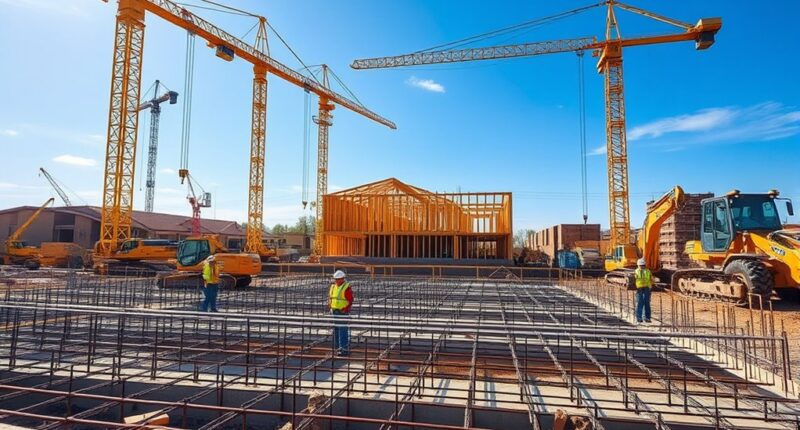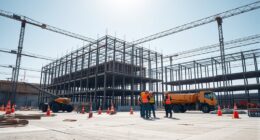From planning and permit approval to site prep, you’ll prepare your lot before groundbreaking begins. Then, the foundation gets poured, framing is built, and exterior work, including roofing, starts to take shape. As weather allows, interior finishes like flooring and painting come next. Inspections guarantee quality, leading to a final walkthrough and punch list. Once all issues are addressed, you’re ready to move in—continue to find out how each stage unfolds.
Key Takeaways
- Permitting and site prep typically take several weeks to months before groundbreaking can occur.
- Foundation work, including excavation and concrete pouring, usually spans 1-2 months.
- Framing, exterior, and roofing installation may take 2-3 months, weather permitting.
- Interior finishes like drywall, flooring, and fixtures generally require 2-4 months.
- Final inspections, punch list completion, and move-in preparations often take 1-2 months.
Planning and Permitting Phase

Have you ever wondered what it takes to get a new build project off the ground? It all starts with steering zoning regulations and obtaining permit approvals. You’ll need to review local zoning codes to ensure your project complies with land use restrictions, setbacks, and building height limits. Once you confirm your plans fit within these regulations, you’ll submit permit applications to the city or county. This process involves detailed drawings, project descriptions, and sometimes environmental assessments. Permit approvals can take weeks or months, depending on the jurisdiction and project complexity. During this phase, expect back-and-forth communication with officials, making adjustments to your plans if necessary. Securing these permits is essential before moving on to site preparation and actual construction. Additionally, understanding building codes and how they influence your project can help prevent delays during the permitting process.
Site Preparation and Groundbreaking

So, you’re ready to move from planning to action—it’s time for site preparation and groundbreaking. This phase involves clearing the site, which includes removing trees, debris, and old structures to create a clean slate. You’ll also coordinate utility hookups like water, electricity, and sewage, ensuring all connections are ready for construction. Proper site preparation sets the foundation for a smooth build process. Here’s what to expect:
| Step | Description | Timing |
|---|---|---|
| Site Clearance | Removing obstacles and debris | Early in the phase |
| Utility Planning | Arranging hookups and permits | Concurrent |
| Groundbreaking | Official start of construction | After prep |
| Inspection | Ensuring readiness for foundation | Before foundation |
| Final Checks | Confirming site readiness | Pre-construction |
Getting these steps right guarantees your build starts on solid ground. Additionally, understanding groundbreaking procedures can help ensure compliance with local regulations and smooth progress through the construction phases.
Foundation and Framing Construction

Once your site is prepared, the foundation gets poured and needs time to harden before moving forward. The framing process then begins, where your chosen materials are assembled to shape the structure. Understanding these steps helps ensure your build stays on schedule and meets quality standards. Incorporating natural materials during framing can enhance the rustic aesthetic typical of farmhouse design.
Site Preparation and Excavation
Are you wondering what happens during the initial phase of construction? During site preparation and excavation, your team assesses soil stability to guarantee a solid foundation. They clear the site of vegetation, debris, and any obstructions. Excavation involves digging to the correct depth for the foundation, shaping the terrain, and creating space for drainage systems. Proper drainage is essential to prevent water accumulation, so drainage systems are installed early on to guide water away from the structure. This stage sets the stage for the foundation and framing work, ensuring the site is level, stable, and ready for construction. Accurate excavation and preparation minimize future issues, making this a critical step in turning your building plans into reality. Incorporating Fokos techniques can also enhance site stability and long-term durability.
Foundation Pouring and Curing
After preparing and excavating the site, the next step is to lay the foundation, which forms the base of your building. You’ll pour the concrete into the formwork, guaranteeing a solid, level base. Once poured, foundation curing begins, allowing the concrete to gain strength over time. Proper curing is essential for achieving maximum concrete strength and durability. During this period, you’ll need to keep the surface moist and protected from extreme temperatures. This process typically lasts several days to weeks, depending on weather and concrete mix. You’ll also monitor the curing process to prevent cracks and ensure the foundation reaches ideal strength. Maintaining appropriate moisture levels during curing is critical to prevent defects and achieve optimal results. When curing is complete, your foundation is ready for the framing phase that follows.
Framing Material and Assembly
What materials you choose for framing can substantially impact your build’s stability and longevity. Common options include wood, steel, and engineered lumber, each with unique benefits. Wood framing is traditional, versatile, and easier to work with, while steel offers strength and resistance to pests and fire. Engineered lumber provides added stability and consistent quality. Your choice also influences insulation options; tighter framing minimizes gaps, improving energy efficiency. Framing techniques vary, from platform framing to balloon framing, affecting construction speed and precision. Proper assembly guarantees the structure’s durability and safety. Coordinating your framing material and technique early on helps streamline the process, reduces waste, and sets a solid foundation for installing insulation and other systems later in the build. Additionally, selecting the right framing material can affect the overall durability of the structure, ensuring your new home withstands various environmental factors over time.
Exterior Work and Roofing

After completing the framing and exterior walls, it’s time to select your roofing materials and plan for exterior finishes. Weather conditions can impact how quickly and smoothly this phase progresses, so planning around forecasts is essential. Proper choices now set the foundation for a durable, weather-resistant exterior that lasts. Additionally, ensuring that installation and venting comply with local regulations is crucial for safety and efficiency.
Framing and Exterior Walls
As the framing stage begins, crews will focus on constructing the exterior walls and installing the roof structure. This phase sets the foundation for your home’s shape and stability. You’ll see the framework rise, with window framing taking shape to guarantee correct placement and size. Insulation installation often starts at this stage, helping to improve energy efficiency early on. Additionally, incorporating insulation within walls is essential for thermal performance and long-term energy savings.
Roofing Material Selection
Choosing the right roofing material is a essential step that impacts your home’s durability, energy efficiency, and aesthetic appeal. When selecting shingles, consider their durability; high-quality options resist weathering and last longer, reducing replacement costs. Roofing insulation is also fundamental, as it helps regulate indoor temperatures and lowers energy bills. Different materials offer varying levels of insulation and protection against the elements. Asphalt shingles are popular for their affordability and decent durability, while metal roofs provide excellent longevity and insulation benefits. Your choice should balance aesthetics with performance, ensuring your roof withstands the local climate. Additionally, incorporating advanced roofing materials such as cool roofs or reflective coatings can further enhance energy efficiency. Remember, a well-chosen roofing material not only enhances curb appeal but also adds to your home’s overall value and resilience.
Weather Impact Considerations
Weather conditions play a significant role in determining the success of exterior work and roofing projects. Unfavorable weather can cause seasonal delays and impact the quality of your build. Rain, snow, and high winds can halt progress and compromise weatherproofing strategies. To minimize risks, your construction team will monitor forecasts closely and adapt schedules accordingly. Additionally, incorporating weatherproofing techniques can help safeguard exposed surfaces against unexpected weather changes.
Key considerations include:
- Timing roofing installation during dry, mild weather
- Using weatherproofing techniques to protect exposed surfaces
- Planning for potential delays in colder months
- Ensuring proper insulation and sealing before adverse weather hits
Understanding these factors helps you stay prepared and guarantees your project stays on track despite seasonal challenges. Proper planning and weatherproofing strategies are essential for a successful build.
Interior Installations and Finishes

Once the structural framework is complete, you can begin installing interior features and applying finishes. This phase involves setting up essential elements like interior lighting, which brightens your space and highlights design features. You’ll also focus on cabinetry installation, ensuring your kitchen and storage areas are functional and stylish. During this stage, walls are painted or textured, flooring is laid, and trim work is added to create a polished look. Attention to detail is key, as these finishes define your home’s aesthetic. You’ll coordinate with tradespeople to ensure everything aligns correctly and meets your preferences. This step transforms the raw shell into a comfortable, inviting environment, bringing your vision closer to reality before moving on to the final inspections.
Inspections and Quality Checks

As construction progresses, conducting thorough inspections and quality checks becomes essential to guarantee everything meets safety standards and your expectations. Following proper inspection protocols ensures that each phase adheres to building codes and quality assurance benchmarks. These checks help identify issues early, preventing costly corrections later. During this stage, you’ll see your project undergo rigorous assessments, including structural integrity, electrical systems, plumbing, and finishes. Regular inspections verify that workmanship aligns with specifications. Engaging in these protocols minimizes errors and ensures durability. Keep an eye on the process to confirm that quality assurance measures are being followed meticulously. This proactive approach guarantees your new build is safe, reliable, and ready for the next steps toward completion.
Thorough inspections ensure safety, quality, and durability throughout construction progress.
- Structural and safety inspections
- Electrical and plumbing assessments
- Material and workmanship reviews
- Compliance with local codes
Final Walkthrough and Punch List

The final walkthrough and punch list are critical steps to make certain your project is ready for move-in. During the final walkthrough, you’ll inspect the entire build, checking that everything matches your expectations and contract specifications. This is your opportunity to identify any issues or incomplete work. The punch list is a detailed document listing items that need correction or finishing touches before you can move in. As you review, note repairs, adjustments, or touch-ups required. Communicate these findings to your builder promptly. Once all items on the punch list are addressed, you can confidently proceed to the next phase. The thoroughness of this step ensures your new home is safe, functional, and exactly as you envisioned before occupancy.
Move-In and Post-Construction Steps

After completing the final walkthrough and addressing any punch list items, you’re ready to move into your new home. This is an exciting step, but it’s also important to stay organized. Use a moving checklist to ensure nothing gets overlooked, from utilities to furniture placement. Once moved in, start exploring decorating ideas to make your space feel like your own. Prioritize unpacking essentials first, then gradually add personal touches. Consider setting up safety features like smoke detectors and security systems early. Take time to familiarize yourself with your new neighborhood. Remember, settling in is a process—patience makes it easier. Finally, enjoy making your house a home, one decorating idea at a time, and celebrate your new beginning.
Frequently Asked Questions
How Long Does Each Construction Phase Typically Take?
You might wonder how long each construction phase takes. Typically, construction schedules outline key timeline milestones, including site prep, foundation, framing, and finishing. Each phase varies depending on project size and complexity, but most residential builds span several months. Foundation work could take a few weeks, framing around a month, and finishing another few weeks. Staying aware of these milestones helps you track progress and make certain the project stays on schedule.
What Unexpected Delays Could Impact the Timeline?
Imagine your build as a voyage across uncertain seas. Allow delays and material shortages are like storms that can slow your progress unexpectedly. These disruptions might delay construction phases, pushing back your move-in date. Staying flexible and communicating regularly with your builder helps navigate these turbulent waters. Being prepared for such unforeseen setbacks ensures you remain on course, even when the journey takes an unexpected detour.
How Is Communication Managed During the Build Process?
During the build process, you’ll receive regular project updates through your contractor, ensuring you’re always informed. Good communication is maintained by scheduled meetings, emails, or calls, making it easy to ask questions or express concerns. Contractor selection plays a vital role; experienced builders prioritize clear communication, helping you stay confident and involved throughout the project. This keeps delays or issues manageable, ensuring your build stays on track.
Are There Options to Customize the Design Mid-Construction?
You have some options to customize your home during construction, but design flexibility may diminish as the project progresses. Early on, you might be able to make changes that enhance renovation potential later, like adjusting layout or finishes. However, once framing begins, modifications become more challenging and costly. It’s best to communicate your preferences early to maximize customization and ensure your new build aligns with your vision.
What Costs Are Involved Beyond the Initial Budget?
They say “hope for the best, prepare for the worst,” and that’s wise when considering costs beyond your initial budget. Expect potential budget overruns due to unforeseen expenses like permit fees or changes in material costs. These additional costs can catch you off guard, so it’s smart to allocate extra funds for unexpected expenses. Staying flexible and informed helps you manage these costs without stress.
Conclusion
Remember, patience is a virtue, especially in new builds. As you watch your dream home come to life from groundbreaking to move-in, stay engaged and trust the process. Every step—planning, construction, inspections—brings you closer to your new beginning. While delays can happen, perseverance pays off. Soon enough, you’ll be settling in, knowing that good things take time. After all, Rome wasn’t built in a day, and neither is your perfect home.









